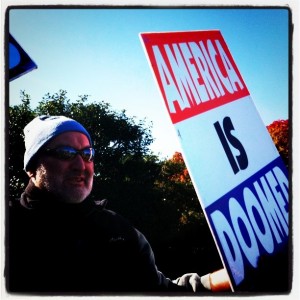Hello,
I am a graphic designer and I am interested in the visual language of protest movements, and of DIY self-publishing initiatives. Your church has set itself up to maximize the transmission of your message — actually incorporating a sign-making operation into your physical building (and basically an in-house art department), along with your video editing/production, and of course your distribution method of protests and web publishing.
I’m afraid that I have many questions to ask you about your signs, and they are kind of esoteric, so if you don’t think they’re worth answering, that’s OK. I’m sure you’re busy. But here goes:
1. When you were designing your signs, how did you choose the typeface, and was the graphic style (color, layout) referencing past historical models, such as old political campaign signs? Or did they just develop as you went along? How did you decide what typeface the word of God should be rendered in?
2. How do you understand the relationship between a church and its communication stream? Is your print shop, and by extension your sign campaign, a more fragmented/media-savvy alternative to an “evangelist”? Would you consider your sign campaign to represent a manifesto of sorts?
3. You write/design your signs to be concise so that they transmit easily through various media streams, but many of them are also slightly cryptic — for example, “Pray For More Dead Soldiers” probably confuses many
people the first time they read it. It requires a level of decryption, almost like a puzzle, to understand the logic (of course once you understand the message, the sign reveals itself to actually be incredibly straightforward).
How did you come to this strategy of provoking people with outrageous but perplexing statements, and forcing them to make an effort to understand you?
4. How do you come up with the messages for your signs? Is one person responsible for the messages, or do they get generated in a more organic way among the church? Is creating the signs a bonding/conversational moment for members of the church?
5. Of course the signs would not be as effective if you weren’t using them at controversial places such as funerals. Was there a moment when you had the revelation that protesting funerals would amplify your message? Are the signs really only byproducts of your protest strategy?
6. This is kind of a random question, but as people who believe in spreading truth to the masses, do you approve of Julian Assange and his Wikileaks operation? The Westboro Baptists and Wikileaks have both challenged our understandings of what “free speech” entails. Having now won your case in the Supreme Court, do you empathize with the predicament that Wikileaks is in?
OK that was a lot of questions. If there is something online that already addresses any of these issues, feel free to send me a link.
And thank you for your time!
Hi –
1. We use Boulder (ttf). It is what our Pastor just settled on years ago – and since it is very readable, yet not commonly used, I always thought it gave us a distinctive look. Every once in a while, if it is topically warranted, we vary from Boulder, but not often.
2. Wow. That’s a long and convoluted questions. Here’s what I think you’re looking for: Our job is to preach this word to every creature. So we hold brightly colored signs at events that lots of people go to. And sometimes these signs end up in photos on tv, in newspapers, and online. Our signs have timely, topical Bible sentiments on them. Our ‘manifesto’ is the Bible – the word of God.
3. Our signs have short, pithy messages on them for two main reasons: 1) so we can make the words big so that you can see them from far away, and 2) because we live in the ‘sound bite’ generation, so you have to get
after it quickly. We aren’t about being ‘cryptic’ – we are about being plain and clear (the pastors of this world are the ones who confuse). Every once in a while, a sign needs a bit of ‘fleshing out’ and if someone is interested in
asking us the sign’s meaning or our motive for holding it, we are always good to answer. Sometimes sparking a dialogue can be a good thing, as long as the end of it is obedience to God. 
4. All members have ideas for signs. Some of our people design the signs, others assemble them, still others manage them, and all of us hold them.
5. The Holy Spirit of God shows us where to go. Our pastor, who has been led by God all of his days, came to realize that these soldier funerals were more patriotic pep rallies than they were serious, mournful exercises in humbling oneself to God – celebrating a nation that is awash in sin at every level – so we started going, telling those present (among other things) that their sons’ and daughters’ deaths are not blessings from God, but
curses – and that they died ignoble deaths fighting for a nation awash in sin.
6. God put the first Amendment into play so that we could preach on this day. God caused the Supreme Court decision. We don’t really care much about Wikileaks’ woes. Much of the rest of the world would jail us just for
stepping foot on their nation’s soil – because of what we believe and because of our open testimony against this world. It is an evil world – if they don’t like what you say or how you say it, they will try to shut you down. But there is no shutting down God. No man can stay His hand or say ‘what doest thou?’.
Hope this helps.
Best Regards,
WBC member
